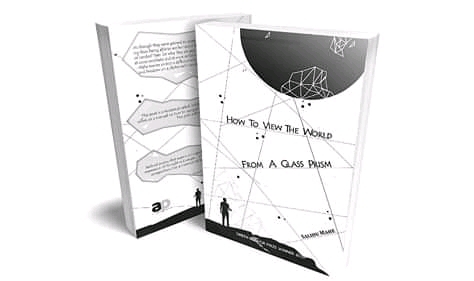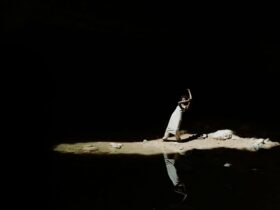Salihu Mahe
How to View the World from a Glass Prism
Abuja: Authorpedia Publishers, 2020, Pages: 53
I
TWENTY YEARS or so ago one would be hard pressed to pick out a poet writing in English in Northern Nigeria from a line up, even with a gun pressed to one’s head. Now there is literally a deluge of poets, as clichéd as it sounds, when it rains poetry, it pours in many Northern Nigerian cities, from Kano to Ilorin to Minna to Kaduna to Makurdi to Gombe, Sokoto and Maiduguri.
Among the literature genres, poetry is currently enjoying some kind of a boom, some late bloom and a critical renaissance. There are many writers’ groups, artists’ collectives, online forums and numerous Facebook chatrooms and Whatsapp groups in Universities, Colleges and virtually in all the cities across the region. These poets are mostly young men and women, many of whom are graduates of disciplines far removed from the humanities, the traditional domain of poetry. They write by far some of the most scintillating, nuanced and to some extent hard to categorise poetry. Their most dominant idiom is the demotic and the overriding subject is the vagaries of love and the subtleties of romance and the romantic; their style is variegated and leans towards the innovative; they are hopelessly romantic while at the same time staunchly political and socially conscious.
One other feature of this group of writers is that they do not appear keen to publish in the traditional brick-and-mortar publishing industry, preferring instead to make their poetic presence felt online: on Instagram where their poems are often engraved and filtered with the latest photo editing software on frames and memes with exotic backgrounds and fonts, on Facebook pages, sometimes on Twitter and more often than not, in web-based journals and magazines. Some of them write with the social media in mind, hence their works are therefore minimalist and popular, while some happen to just favour the social medium without compromising their style or voice to blend with the online cacophony.

II
Among this ensemble of poets that are making wave not just in Northern Nigeria, Nigeria as a whole and indeed in the larger creative world is Salihu Mahe. How to View the World from a Glass Prism is his debut collection and before its present reincarnation as a full volume, the collection (as a chap book) won the “Words Rhymes a Rhythms’ Green Author Prize” in 2019. Mahe joins a long list of authors whose professional training or affiliation inform or form the basis of their arts, writers such as the medical doctor, Dr Dami Ajayi, Dr Mariya Sidi, Dr Marzuq Ungogo, Naseeba Babale and many others. Mahe trained as an engineer and the title of the collection under review easily manifest his academic training and persuasion. This is not to suggest that the collection is reductive, or the poet’s poetic purview and concerns are narrow, or that the poetry could be read in relation to Physics to which prism attests to. Rather, the collection as a whole imbues the vexed and the old love-hate relationship, which used to exist between science and poetry and the arts generally.
III
It is commonplace that scientific inquiry is closely hinged upon the twin concerns of measuring and describing things that are often beyond our immediate senses. As such, one can argue that poetry which—as we have here in How to View the World from a Glass Prism—tilts towards science is a tool not just for measuring and describing what is beyond the immediate senses, but for tracking down and making sense of what is out of range too.
For most people, the penetrating obscurity and mysticism of much of modern science means it is simply out of range. In the same vein, the connection between science and poetry is increasingly becoming more tenuous and farfetched, straining into irrelevance and incongruity. Certainly, there are few poets that are still working in that tradition (a good example of which would be the British poet, Diana Syder, whose book, Maxwell’s Rainbow [2002]) is acclaimed as one of the best collections of science-based poetry). But even at that, poems about science are not what you would expect from a young poet like Salihu Mahe.
In How to View the World from a Glass Prism, the science is overt, and as it were, forms part of the structure of the poems. In most of the poems, science (or its different varieties: Physics, chief among them) informs not just the poetic structure and the themes, but the content in a more generic way, and seamlessly it is fitted into the background of the poet’s thoughts, attitudes and sensibilities. Yet despite the pervasive presence of science in the collection as a whole, it is not easy categorising which are the science poems and which are not, and which I sense is how the poet wants the readers to also regard them. All the same, there is what could be called ‘marshalling’ of the poems into different chiefly notional sub-sections, each determined by a particular scientific concern informed by a specific scientific strand.
For most part, science (and not so much its practitioners surprisingly) is the dominant subject, but more often it is simply used to gain an insight and wisdom about the world and the behaviour of the poet-persona towards it. The poems are punched (so to speak, like most science poems) beyond any easy, predictable ending, and in the end what gives the reader a buzz about the poems is finding some scientific insights that were not there at the start of the poem.
Poets who turn their attention to science often write with aloofness and detachment that can turn them into mere spectators, heralding the excitement of the subject they are enthusiastically writing about; but not so Salihu Mahe, who despite being young is already in possession of a uniquely promising talent. His curiosity about the scientific realm and his inquiring sensitivity makes him as in “How to Train your Dragon” simply a fine voice sensitive poet as well. His sensibility allows him to go beyond the traditional range for poets, and one of the best poems here is about poetry. Indeed his curiosity takes him into strange places—into the eponymous prism, memories, the realm of the dragon and corpse—unusual features of science poetry that are evoked with a sense of exhilaration and wonder. These poems have that most attractive quality: they are simply interesting and no less innovative.
IV
The operating motif and mantra of the poems collected here is “howism”: each of the 28 poems is either titled “how to…”, or “this is how to. . .”, giving the collection a feel of a self-help book. Yet it is that feel that makes the volume unique; for the poet feigns and assumes a different persona and voice to use congruent and parallel poetic optics to deviate a familiar “beam” or invert a “clichéd” image into a fresh one. So the overriding metaphor of a prism allows the poem to delve into what we think we know and turn them into something that may shock and awe us. This is evident right from the first poem, “This is How to Make Memories I”: First/Flirt with time/Second/Seize the moment.
Some of the poems have a texture and indeed the tincture of minimalism: they read like Nietzschean aphorisms, punching over and above their wee appearance on the page, and in this category belongs poems such as: “How to Live and Die”, “Burial Made Easy”, “This is How to Trust a Loved One” and “How to Find a Wife”.
Though the poems are not grouped into any discernible division, yet the poems sort of “group” themselves into some notional “cohere” like the aphoristic poems mentioned above. And there is yet another grouping for the non-aphoristic, fairly long poems sometime with a bit of long lines. Here too the poet handles the demand of long poetic lines with ease and this group of poems include: “How to Honour the Memories of your Father”, “How to View the World” and “How to Look at Glass Houses”.
V
The poems are emboldened by the accompanying drawings which graphically not just complement and supplement in the true Derridean style the poems but also render them in a non-verbal, preternaturally double textual mode. While for a non-science person like my humble self, it may well-neigh be impossible to domesticate and poeticise the prism, it is the most natural and indeed easiest of task for a poet like Salihu Mahe who is on top of his game in How to View the World from a Glass Prism.
In the last analysis, How to View the World from a Glass Prism emerges as a collection in which Salihu Mahe expresses poetic wisdom: an order of higher, paradoxical or purely intuitive thought, which, though not beyond the reach of critical analysis, is an embodiment of successful coupling of form and content, theme and craft, experience and artistic vision. A reader has the right, indeed the valency, to demand something from poetry. Whatever the reader’s demand is, How to View the World from a Glass Prism has already offered, or is in the process of offering them: whether the demand is sheer aesthetic delight for the aesthete, or imagistic complexity, linguistic playfulness and textual and stylistic subtleties for the fastidious critic.

Ismail Bala, author of Line of Sight (Praxis Books, 2020) writes in English and Hausa. His poetry and translations have appeared in the UK, the USA, Canada, India and South Africa, in journals such as Poetry Review, Ambit, New Coin, Okike, A Review of International English Literature and Aura Literary Arts Review. Born and educated to university level in Kano, he did his post-graduate studies at Oxford. He is a Fellow of the International Writing Programme of the University of Iowa.
- CALL FOR SUBMISSION: Dear Yusef: Essays, Letters, and Poems For and About One Mr. Komunyakaa - May 25, 2022
- #SubmitNow: Awaiting Revolution Poetry/Essay Anthology - May 21, 2022
- The Straight Path | Adamu Yahuza Abdullah - May 20, 2022













Leave a Reply